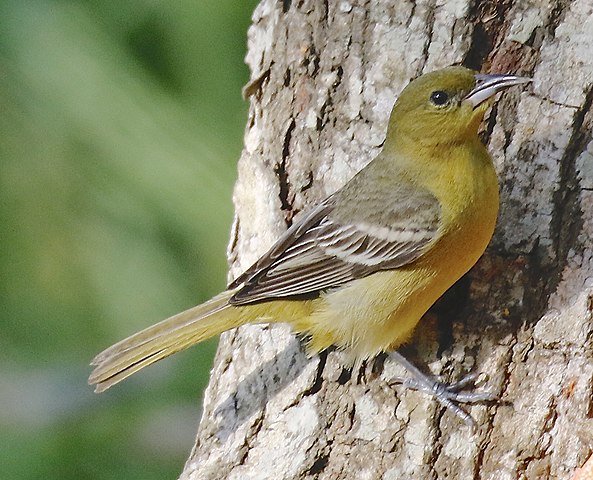A Slender Bird Whose Color Intensity Ranges From An Intense Bright Orange To Yellow Depending On Where They Live!

A rather slender oriole ranging from bright orange to yellow depending on what part of the country they live in.
Meet the Hooded Oriole

The hooded oriole (Icterus cucullatus) is a medium-sized oriole with a bright orange-yellow head and nape, and black back, face, throat, and upper breast, with a slightly decurved bill. The color intensity of these birds ranges from bright orange to yellow depending on where they live. Their black wings have two white bars. The tail is also black.

The adult female is olive-green on the upper parts and yellowish on the breast and belly.
Related Reading:
– Hey, up there 67, our most popular photos up to the week ending 06/19/2022!
Immature males tend to look more like females.

This bird can be found from California and Nevada through to New Mexico and southern Texas south down to northern Mexico. A few spend time wintering in southern California and southern Texas, but most migrate to southern Mexico and areas further south.

Hooded-oriole like to live in deciduous and riparian woodlands and human habitations, often near ranches or towns.

They forage in trees and shrubs, also feeding on flowers. Because it pierces the base of the flower, it does not assist in pollination. These birds mainly eat insects, nectar and fruit, and will also visit hummingbird feeders.

Males arrive at their nesting sites in the last weeks of March and set up breeding territories. The breeding season lasts from April to July in Texas, May to August in Arizona, April to mid-August in California, and May to August in Baja California. Recent reports state that the nests are constructed and secured on the undersides of palms and banana plants. Location and structure materials vary geographically. Arizona nests are often made of grasses and are located in taller trees. Meanwhile, California Nests are made from palm fibers and are located on the underside of palm plants. The Hooded Oriole’s nest is basket-shaped and much deeper than its relatives. Female Hooded Orioles lay a clutch of 3-5 eggs. The eggs are generally white but can range into a pale blue with darker splotches. The eggs are incubated for 12-14 days, and the nestlings take about 14 days to fledge. This species is also commonly parasitized by the Brown Headed Cowbird and the Bronzed Cowbird.

These birds are considered as of Least Concern on the IUCN Red List.

You can watch this bird right here in the video below:
H/T Wikipedia – Creative Commons Attribution-ShareAlike License.
A Complex Myriad Of Vivid Orange, Yellow, Gold, And Black Combine To Create One Of The Worlds Most Remarkably Distinctive Birds!
Please SHARE this article with all your bird-loving friends and family.






